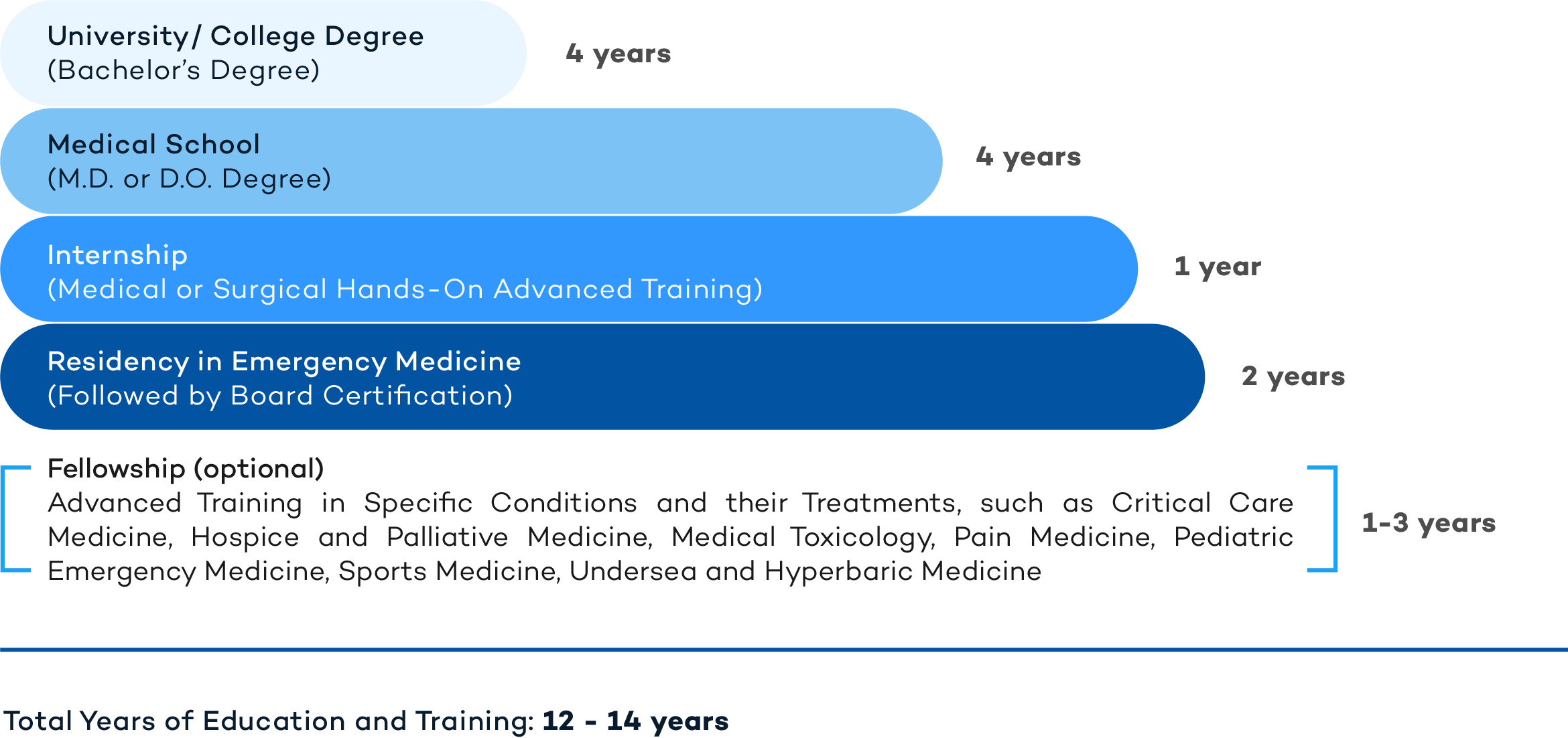

An Emergency Medicine Doctor is a Board-Certified Physician who specializes in treating, diagnosing, and medically managing patients in need of acute or life-saving care. These physicians provide urgent medical care to adults and children and coordinate their care, if necessary, with a multitude of different medical and surgical subspecialties.
The Emergency Medicine Doctor is responsible for the immediate evaluation and treatment of patients with serious or life-threatening injuries or illnesses. These physicians see a diverse patient population with a variety of disease presentations. Emergency Medicine Doctors may practice in traditional emergency room (ER) departments, urgent care centers, or in intensive care units (ICU) in the hospital. These doctors are ultimately responsible for arranging the disposition of a patient - deciding whether to admit them to the hospital or releasing them after acute treatment has been administered in the emergency department. Emergency medicine has a lot of overlap with other fields of medicine such as Internal Medicine, Family Medicine, and Acute Primary Care where virtually any organ system may need to be evaluated promptly in patients of any age.
Emergency Medicine Doctors are physicians (M.D. or D.O.) with advanced medical degrees and training. The following is representation of the years of education and training that the Emergency Medicine Doctor has undergone.

An Emergency Medicine Doctor will treat an extensive list of conditions related to acute illnesses or injury, including:
Asthma Attack: This describes a potentially life-threatening attack of chest tightness, and breathing difficulty with coughing and wheezing. Treatment of an asthma attack consists of a quick assessment to determine the severity of the reaction and if the patient is at risk of potentially fatal asthma (leading to death from the airways being severely constricted or narrowed). Inhaled medications such as bronchodilators (airway ‘openers’) and oral corticosteroids (to reduce airway inflammation) are the mainstays of treatment for acute asthma attacks. More severe cases of asthma may require observation or even hospital ICU admission.
Abdominal Pain: Abdominal pain is one of the most common presenting signs of patients in an emergency department. This pain should be fully evaluated by a physician if it is accompanied by fever, nausea and vomiting, shortness of breath, loss of appetite, weight loss, painful urination, or pain persisting for more than 24 hours. The physician in the ER will use a thorough physical exam, bloodwork, and possibly radiologic studies (X-ray, CT scan, MRI, ultrasound) to help aid in their diagnosis. Depending upon the root cause of the abdominal discomfort, the emergency room physician determines if the patient is discharged home with prescribed medications, is referred for hospital admission for further workup, or is referred to a surgeon if a surgical intervention is deemed necessary.
Behavioral Issues: Mental health and substance abuse issues are leading causes of visits to the emergency room in the United States. An emergent psychiatric issue involves anything that causes an acute disturbance in thought, behavior or mood. Anyone at risk of harming themselves or others is considered a psychiatric emergency and should be evaluated in the emergency department.
Breathing Problems: Shortness of breath can be a sign of many very serious underlying disorders and should almost always prompt an emergency room visit. Breathing problems may be associated with asthma, pneumonia, heart attack, blood clots (pulmonary embolism), or due to allergic reactions (anaphylaxis).
Burns: The severity of a burn determines whether or not a patient should seek emergency care. Mild first-degree burns often do not require medical treatment. Second and third-degree burns, especially if they involve a larger body surface area, require medical evaluation and treatment. In the emergency department, the physician can determine if transfer to a specialized burn center is required for continued care. In these cases, the decision to admit the patient to a burn unit is generally due to any of the following: a partial-thickness burn of more than 10% of the total body surface, burns of the face, feet or hands, third degree burns anywhere on the body, chemical burns, or inhalation injuries.
Cardiac Problems: Chest pain and heart issues prompt many emergency department visits due to cardiac arrest, heart attack, heart failure, aortic aneurysms, arryhythmias, pulmonary emboli, pneumonia, or pericarditis. Symptoms associated with cardiac abnormalities may include chest pain, shortness of breath, extreme fatigue, dizziness or lightheadedness, and weakness, and should receive immediate attention in an emergency setting. Depending upon the physician’s physical exam findings and the results of lab and radiologic workup (if necessary), the next first steps in acute management of the cardiac problem will be determined.
Diabetes: Diabetes is one of the more common chronic medical conditions that may require a patient to visit the emergency due to an uncontrolled disease state. Hypoglycemia (low blood sugar), diabetic ketoacidosis (DKA), and a susceptibility or tendency to infections are the three most serious complications of diabetes, and may require not only emergency room evaluation but ultimately hospital admission.
Gynecologic Problems: There are several gynecologic emergencies that need to be recognized urgently, including: an ectopic pregnancy (the egg never makes it to the uterus and becomes fertilized by the sperm in the Fallopian tubes, where it also implants and the pregnancy will take place, instead of in the uterus), an evolving miscarriage,pelvic infections, and complicated or ruptured ovarian cysts. Although gynecologic symptoms may mimic those of other abdominal problems, heavy vaginal bleeding and/or menstrual cramping may also be present, so proper diagnosis through exam and radiologic and laboratory workup with acute management are paramount.
Stroke: A stroke occurs when there is a sudden interruption of the blood supply to a portion of the brain. This blockage prevents oxygen and nutrients from reaching the brain tissue and cell death may begin within minutes. Strokes are true medical emergencies, and early intervention may reduce morbidity and be life-saving. There are two types of strokes - ischemic (blood vessels are blocked or narrowed) and hemorrhagic (a blood vessel in the brain ruptures or leaks). Signs of a stroke include: difficulty speaking or standing, paralysis, visual disturbances, headache, or difficulty walking. Suspected strokes will require a physical and neurologic exam, bloodwork, and imaging studies such as a CT scan, MRI, carotid artery (in the neck area) ultrasound or echocardiogram. Initial treatment of a stroke is aimed at the underlying cause, so ischemic strokes require clot busting medications or direct endovascular procedures to remove the blockade. A hemorrhagic stroke requires reducing pressure in the brain and stopping the bleeding via surgical intervention or endovascular embolization (surgically filling the holes of the affected vessel or tissue).
Injuries/Trauma: All levels of injury or trauma are seen in the emergency department, from minor burns to broken bones, lacerations, and motor vehicle accidents. The Emergency Medicine Physician is essential in the initial management of an injury, which may be due to virtually any kind of traumatic event.
Emergency Medicine Physicians, whether in emergency departments or urgent care clinics, play a vital role in the acute management of mild to severe medical emergencies. They routinely see patients of all ages and must maintain a vast medical knowledge base for the proper management of medical, surgical, pediatric, and gynecologic issues that may present.
You can read more about Emergency Medicine in the following links:
https://www.acep.org
https://www.aaem.org
https://www.abem.org/public